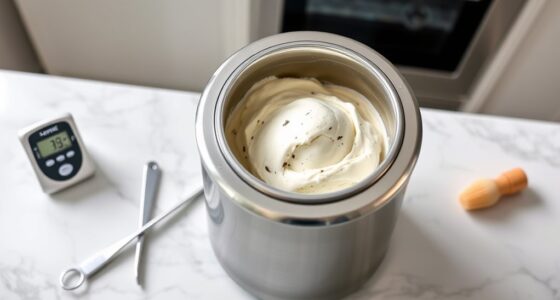Yes, making ice cream without a machine definitely works. You simply mix heavy cream and sweetened condensed milk, then add your favorite flavors or mix-ins before freezing. Stir it every few hours during freezing to keep it smooth and creamy. While it may not be as perfectly uniform as store-bought, it’s still delicious and customizable. Keep going to discover tips and tricks to get the best homemade no-churn ice cream!
Key Takeaways
- No-churn ice cream methods, like mixing heavy cream with condensed milk, effectively produce creamy textures without a machine.
- Regular stirring during freezing prevents ice crystal formation, improving smoothness and creaminess.
- Ingredients such as heavy cream and sweetened condensed milk help mimic machine-churned ice cream’s texture.
- Proper freezing, airtight containers, and patience are crucial for achieving desirable results at home.
- DIY no-machine ice cream can absolutely work, offering customizable flavors and satisfying creamy consistency.
Popular Methods for Making No-Churn Ice Cream at Home

If you want to make no-churn ice cream at home, there are several popular methods to choose from. One common approach involves mixing heavy cream with sweetened condensed milk, then adding your favorite flavor combinations like chocolate chips, fruit purees, or cookie crumbs. You can also fold in flavorings such as vanilla extract or coffee for extra depth. Once combined, transfer the mixture to a lidded container and freeze. To keep your ice cream fresh and prevent freezer burn, follow storage tips like wrapping the container tightly with plastic wrap or using an airtight container. Stirring the mixture every few hours during the initial freezing phase helps improve texture and creaminess. These methods are simple, versatile, and allow you to customize flavors easily.
How Do No-Machine Ice Cream Recipes Achieve Creaminess?

No-churn ice cream recipes achieve their creamy texture through a combination of ingredients and techniques that mimic traditional churning. They rely on milk fat and air incorporation to create a smooth, rich consistency. Milk fat adds richness and body, preventing the ice cream from feeling icy or icy. Meanwhile, air gets trapped during mixing or whipping, giving the ice cream a light, fluffy mouthfeel. To enhance creaminess, recipes often include sweetened condensed milk or heavy cream, which boost milk fat and facilitate air incorporation. This process results in a dense, velvety texture without a machine. Here’s a simple breakdown:
| Ingredient | Role |
|---|---|
| Milk fat | Adds richness and smoothness |
| Air incorporation | Creates lightness and fluff |
| Sweetened condensed milk | Boosts milk fat and sweetness |
| Heavy cream | Provides creaminess and air |
Additionally, understanding the science of freezing helps explain why these ingredients work together to produce such a satisfying texture. Using emulsifiers like egg yolks or commercial stabilizers can further improve the creaminess and stability of no-machine ice creams, making them even closer to the texture of churned varieties. Moreover, proper freezing techniques are essential to prevent ice crystal formation and maintain a smooth texture, especially in homemade recipes. Furthermore, consistent exfoliation with glycolic acid can help improve skin texture, making it smoother and more refined.
Comparing Texture and Flavor: Homemade vs. Store-Bought

When comparing homemade and store-bought ice cream, you’ll notice distinct differences in texture and flavor that reflect their preparation methods. Homemade ice cream often has more texture variation due to less stabilizers and emulsifiers, resulting in a creamier or sometimes icier consistency. Flavor consistency can vary based on ingredients and mixing techniques, giving you a more customizable experience. Store-bought varieties, on the other hand, usually offer uniform texture and flavor, thanks to commercial processes. Texture stability can be more challenging to achieve at home without specialized equipment, influencing the final product’s consistency.
- Flavor consistency: Store-bought tends to be more uniform, while homemade flavors may vary with each batch
- Texture variation: Homemade ice cream can be creamier or icier, depending on ingredients and freezing methods
- Freshness impact: Homemade often tastes fresher, enhancing natural flavors over store-bought options
Tips and Tricks for Perfect No-Machine Ice Cream Results

Achieving perfect no-machine ice cream relies on simple techniques that can make a big difference in texture and flavor. To enhance your results, experiment with flavor combinations like chocolate and peppermint or strawberries and balsamic. For a smoother texture, stir your mixture every 30 minutes during freezing to break up ice crystals. Proper storage tips include using airtight containers to prevent freezer burn and consuming within a week for ideal freshness. Consider layering flavors or mix-ins to create exciting combinations. Chilling your ingredients beforehand helps improve consistency. Keep in mind that patience pays off—freezing times may vary, but consistent stirring will yield creamier ice cream. Additionally, understanding the AI Entertainment trends, such as generative AI tools, can inspire creative ways to design unique flavor profiles or presentation styles for homemade ice cream. Being aware of hackathon innovations might even inspire new methods for developing or sharing your recipes. Use this table as a quick reference to refine your no-machine ice cream process:
| Tip | Technique | Benefit |
|---|---|---|
| Flavor combinations | Mix complementary ingredients | Richer flavors |
| Stir regularly | Break up ice crystals | Smoother texture |
| Storage tips | Airtight containers | Maintains freshness |
| Chilling ingredients | Pre-chill liquids | Better texture |
Common Mistakes and How to Avoid Them

Even with the best techniques, it’s easy to make mistakes that can compromise your no-machine ice cream. One common issue is overmixing errors, which can lead to a grainy texture instead of smoothness. To prevent this, mix just until ingredients are combined and avoid excessive agitation. Improper freezing is another mistake; if your mixture isn’t cooled evenly or frozen too slowly, ice crystals form, making it icy and hard. To avoid this, chill your mixture thoroughly before freezing and stir frequently during the freezing process. Additionally, neglecting to cover your container can result in ice crystals and freezer burn. Keep your mixture covered tightly and monitor the freezing process to ensure a creamy, scoopable result. Incorporating mindful techniques like mindful stirring and proper temperature control can also improve your ice cream’s texture and overall success. Being aware of freezing methods and how they influence ice crystal formation can help you adapt your process for optimal results based on your specific environment. Using methods such as temperature regulation can further help in achieving a smooth, creamy consistency.
Frequently Asked Questions
Can I Make No-Churn Ice Cream With Dairy-Free Ingredients?
Yes, you can make no-churn ice cream with dairy-free ingredients. You just need dairy-free options and vegan substitutions like coconut milk, cashew cream, or almond milk. Whip these with sweeteners and flavorings, then freeze. The result is creamy and delicious, and you won’t miss dairy. Just make certain you choose the right dairy-free options to achieve the smooth, scoopable texture you want in your homemade vegan ice cream.
How Long Does Homemade No-Machine Ice Cream Stay Fresh?
You wonder how long your homemade no-machine ice cream stays fresh. Typically, it lasts about 2 to 4 weeks in the freezer if you store it properly. To maximize freshness, use airtight containers and avoid frequent temperature changes. Keep the ice cream cold and cover the surface with plastic wrap before sealing. Following these refrigeration tips guarantees your homemade treat remains tasty and safe to enjoy longer.
Is There a Way to Make No-Churn Ice Cream Healthier?
Thinking of making your no-churn ice cream healthier is like planting a seed for better choices. You can swap in healthier ingredients and natural sweeteners like honey or maple syrup. Using fresh fruits instead of processed flavors and choosing low-fat dairy options helps reduce sugar and fat. These simple tweaks turn your treat into a smarter, guilt-free indulgence, proving that healthier ice cream is totally within your reach.
Can I Add Alcohol to Improve Texture in No-Machine Ice Cream?
You can add alcohol to improve texture in no-machine ice cream through alcohol infusion, which helps prevent ice crystals from forming and creates a smoother consistency. Keep in mind, though, that too much alcohol can prevent proper freezing. Use a small amount—about one to two tablespoons per batch—to achieve texture enhancement without compromising the ice cream’s firmness. Experiment carefully to find the right balance for your preference.
What Are Alternative Sweeteners for No-Churn Ice Cream Recipes?
Thinking about alternative sweeteners for no-churn ice cream is like exploring a new flavor palette. You can use sugar substitutes or natural sweeteners like honey, maple syrup, or agave nectar to add sweetness without refined sugar. These options blend well with your ingredients, offering a healthier twist. Just remember, natural sweeteners can impact texture, so experiment to find the perfect balance for your homemade treat.
Conclusion
With a little patience and a sprinkle of creativity, you can craft creamy, delicious ice cream right in your freezer. Imagine scooping up a bowl, the cold, velvety texture melting on your tongue, flavors bursting with every bite. No fancy machine needed—just your hands, a few simple ingredients, and a bit of love. So go ahead, embrace your inner ice cream maker and enjoy the sweet reward of homemade perfection.










